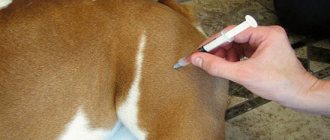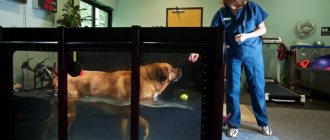Is this advisable?
This problem should not worry owners of private houses.
There, loud barking dogs are taken for granted. But in multi-story buildings, the ringing voice of a pet can annoy neighbors. To avoid conflict situations, some owners decide to cut the ligaments of their pet. But is this really necessary?
Such interference in nature is associated with risks for the animal. You need to weigh everything carefully before exposing your dog to stress for the sake of disgruntled neighbors.
Types of surgery
The purpose of the procedure is to deprive the pet of the “right to vote.”
Surgeons practice 2 methods of cutting:
- if partial, they are cauterized with electric current or cut with instruments;
- when complete, the ligaments are removed and the cut sites are cauterized.
In the first case, the dog will be able to restore its voice, but it will no longer be as ringing and loud. After the second operation, the pet will not bark at all .
Process description
The procedure itself takes no more than 40 minutes. The same amount of time will be spent on blood sampling and analysis.
The intervention technique looks like this:
the anesthesiologist administers anesthesia to the animal;- the dog's head is raised;
- a special device is inserted into the mouth to fix the jaws in an open state;
- surgical scissors are used to make incisions in the ligaments or completely cut them off;
- After packing, the wounds are treated with hemostatic drugs.
The procedure does not require special equipment. Some veterinarians practice surgery at home, where psychologically the animal is subject to less stress.
Expert opinion
Panteleeva Irina Petrovna
Breeder, 11 years experience.
As for the hygienic side, this is a controversial point. In addition, an on-site session is more expensive.
How is surgery to remove vocal cords performed in dogs?
The operation to remove the vocal cords is performed under general anesthesia, with mandatory preliminary preparation. Due to the short duration (approximately 5-10 minutes), the anesthetic risk is reduced.
Surgical access is carried out through the open oral cavity. The ligaments are completely removed. There are no stitches. Minor bleeding stops spontaneously during recovery from anesthesia.
After vocal cord removal:
- The voice may disappear completely - the dog opens its mouth and makes no sounds.
- A “hissing” sound is heard.
- Barking may become muffled and quiet.
Alternative to surgery
Ligament cutting is not a new trend that people are trying to follow, but a last resort.
Before turning to this technique, it is worth considering other options. There are alternative methods that do not harm the animal.
Dog training
There are dog breeds for which incessant barking is a distinctive feature. But most often, ill-mannered individuals raise their voices for no reason.
Training is applied to service dogs, forgetting that small, decorative breeds also need training. By teaching your pet to voice in specific cases, you can avoid a showdown with your neighbors.
Use of sedatives
Dogs bark or howl for a long time out of loneliness: they are locked in an apartment and feel sad.
To prevent the animal from getting excited about this and terrorizing others with loud sounds, it can be given a sedative before leaving.
Your veterinarian will tell you which medications to use..
He will also determine the dosage based on the breed and age of the pet.
Examination by a veterinarian to rule out diseases
A well-mannered dog may show anxiety even in the presence of its owners. This is already a reason to show the animal to a specialist. Perhaps your pet is in pain and is asking for help in a loud voice.
Expert opinion
Makarenko Svetlana Igorevna
Practicing veterinarian, 15 years of experience.
In rare cases, unmotivated barking is a sign of mental pathologies that are inherited. In such a situation, surgery may be the only option to solve the problem.
Is it necessary to do this?
It is worth understanding that performing an operation on an animal is a kind of final step, and, moreover, it is very expensive. Before agreeing to surgery, you should try to check other methods:
- Start training your dog . There are many techniques on the Internet that allow you to control your pet’s behavior. The simplest option would be to raise your voice at the dog if the animal begins to bark for no reason, expressing dissatisfaction with such a “bad habit.”
- Buy sedatives . Perhaps your pet is going through a seasonal period of increased sensitivity. The medications themselves will be much cheaper than the surgery.
- Take the animal to the veterinarian . He may develop a disease that results in increased noise.
If non-surgical methods do not help, and the animal continues to bark uncontrollably, then cutting the vocal cords should be seriously considered.
Pros of the operation
When talking about the benefits of pruning, only one positive point comes to mind. It is connected with the degree of comfort of the owner:
I don’t want to quarrel with my neighbors over a dog;- I also don’t want to strain myself with training;
- you need to constantly spend money on sedatives;
- I also don’t like the “Antilai” collar.
It’s easier to pay for the operation and then calmly coexist with those around you and your silent pet.
Negative aspects of intervention
There is only one argument in favor of the operation, and it is not so significant. But the procedure has plenty of disadvantages:
- Pruning is carried out under general anesthesia, and it has a negative effect on the heart. Many dogs suffer from heart failure, mostly toy breeds. This pathology is asymptomatic, so there is a risk of death caused by anesthesia.
- Due to surgery or exposure to current, the animal may develop laryngeal edema. As a result, the dog suffocates and dies. Everything happens so quickly that the doctor does not have time to take resuscitation measures.
Silencing a pet causes psychological trauma. The dog can no longer communicate with its own kind and becomes a kind of outcast. It is not always possible to find a common “language” with the owner - animals do not know how to express themselves with gestures and facial expressions. All this depresses the animal; it refuses to eat, walk, and gradually withers away.- The opposite situation is also possible: the animal becomes aggressive and attacks everyone. Here another problem will arise - the need for isolation (and, perhaps, euthanasia).
- In the case where the ligaments were not removed, but were only slightly trimmed, the animal barks, but in a “whisper.” In apartments with poor sound insulation, such sounds can annoy neighbors even more. It will also be difficult for the pet to communicate with other dogs: the vibrations in the voice change, making the dog a “foreigner” among his fellow tribesmen.
But the most serious argument is an unqualified operation.
Domestic veterinarians are not trained in this technique. There are only a few clinics certified for this service in Russia, so the risk of complications after a poorly performed operation is high.
After weighing the pros and cons, you should think several times whether such a procedure is justified. After all, an inexperienced doctor can accidentally touch the walls of the larynx, causing severe bleeding. Losing a pet is not worth the money (and there is a lot of it) spent on depriving a dog of his voice.
Pros and cons
There are pros and cons to the operation. There is only one argument that suggests the need for surgical intervention: the pet has stopped constantly barking, which was the original goal.
Arguments against cutting the vocal cords of dogs are as follows:
- The pet’s psyche after surgery may undergo serious negative changes. Some animal lovers claim that dogs express their emotions through their voice. Without the ability to bark, your pet may withdraw into itself, refuse to eat, and avoid attention from others. This behavior often leads to diseases in dogs. Uncontrollable outbreaks of aggression are possible, both towards strangers and towards their owner.
- The anesthesia used may be of poor quality, which will negatively affect the pet’s heart and lead to the appearance of various ailments.
- Difficult course of the operation itself. It is impossible to predict how surgery will affect your pet’s health. The consequences for the dog can be severe, even fatal.
- Swelling of the larynx is possible after the operation. Veterinarians cannot prevent instant suffocation, which leads to the death of the animal.
The dog may develop other difficulties that prevent the vocal cords from being trimmed. Sometimes it depends on the breed of the dog.
Important! Unprofessional actions of a veterinarian can lead to heavy bleeding, which leads to wound infection and aspiration.
The inability to voice can negatively affect the pet's psyche
Caring for the animal after the procedure
If the negative aspects do not frighten the owner, and he is sure that the operation is extremely necessary, he will have to take care of the dog’s further well-being.
The injured throat is cooled immediately after surgery, so there is no need to treat it specially.
Basic care is as follows:
- the first day requires complete rest;
- for a week after surgery, the dog is not given solid food or dry food;
All toys are hidden away during the rehabilitation period so that the dog does not chew them;- no physical activity for 2 weeks;
- The animal, as before, is taken for walks, but they should be measured, without the usual games.
It is important to protect the dog from all kinds of stress during rehabilitation. The animal needs the attention of its owners. It must feel important. Whether the ligaments are removed or not, the dog still remains a pet.
Rehabilitation period
In the first week after ventriculocordectomy, you must carefully monitor your pet's diet. Do not feed him dry food or other solid food. The food should be liquid and warm so that the dog can swallow it easily. It is prohibited to give chewing toys, allow the dog to communicate with other individuals, jump and run. Remember that at this time your four-legged friend needs special attention and care, so it is important to exclude any stressful situations.
To avoid laryngeal edema and ARDS (acute respiratory distress syndrome), you must constantly monitor the dog’s general condition and breathing. If complications occur, you will need to urgently call a veterinarian to perform an emergency tracheostomy (incision in the larynx).










